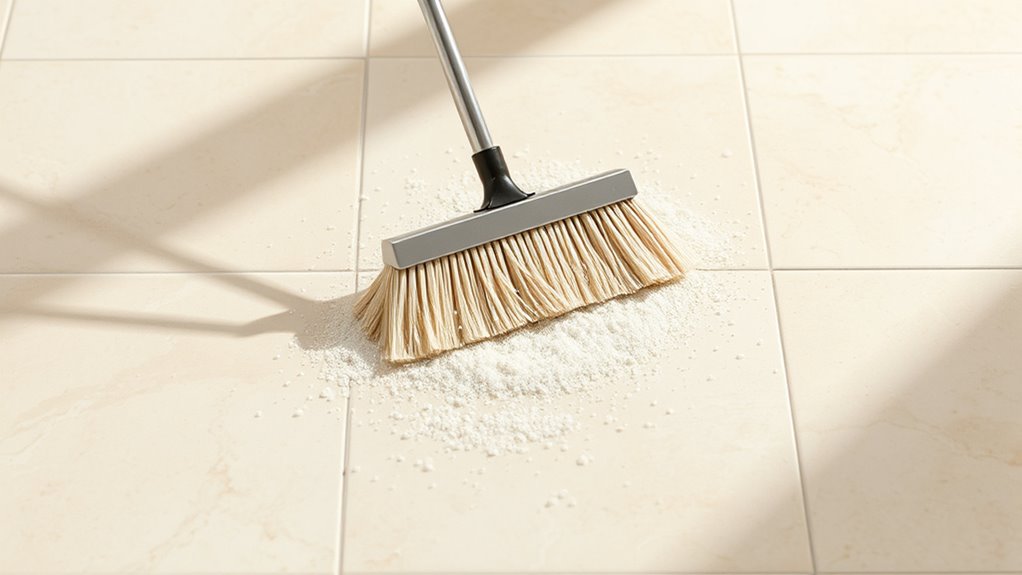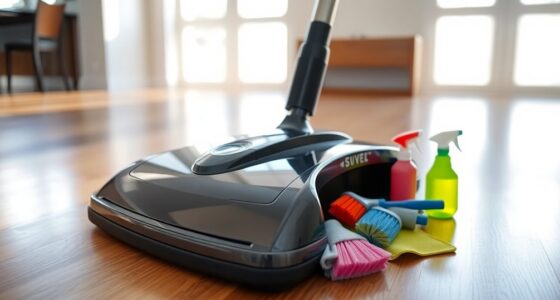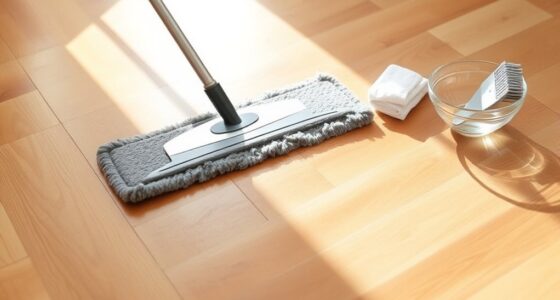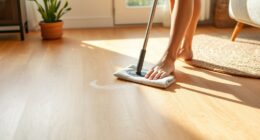To keep your tile floors scratch-free from winter sand and salt, sweep regularly with a soft-bristled broom in gentle, overlapping strokes, focusing on corners and grout lines. Use a dustpan to collect debris efficiently, then mop with a damp, pH-neutral cleaner or mild soap, ensuring the mop is well wrung out. Rinse your tools often and re-clean stubborn spots to prevent buildup. Maintaining consistent, gentle cleaning habits helps preserve your tiles’ appearance—discover more tips to protect your floors effectively.
Key Takeaways
- Use a soft-bristled broom to gently sweep sand and salt without scratching the tile surface.
- Sweep in overlapping, gentle strokes focusing on edges and grout lines where debris accumulates.
- Regularly rinse your broom and dustpan to prevent spreading abrasive particles during sweeping.
- Follow up with a damp, well-wrung mop using a pH-neutral cleaner to remove residual salt and dirt.
- Avoid soaking the floor; instead, mop in small sections to prevent grout damage and surface scratches.
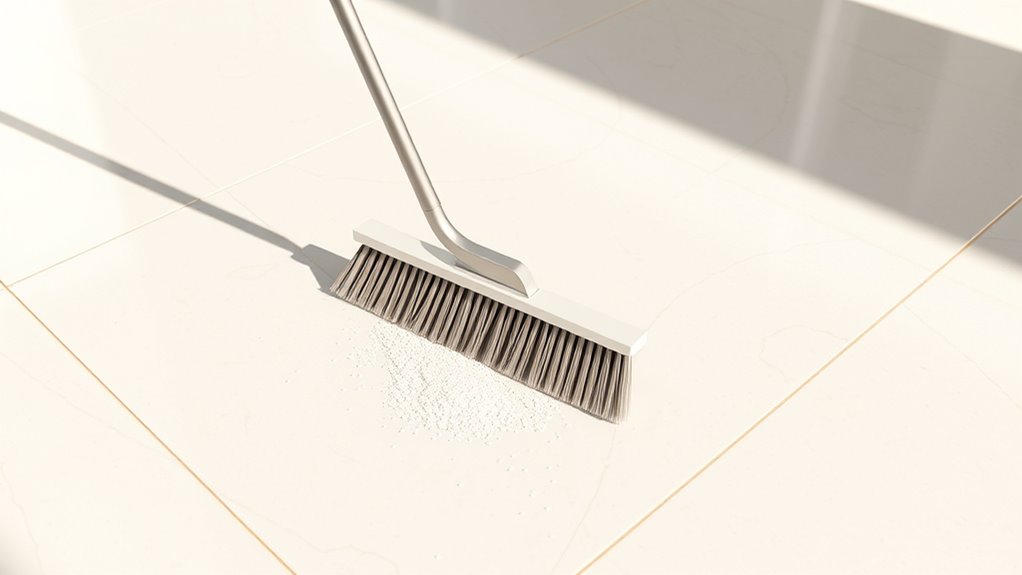
During winter months, sand and salt are commonly tracked onto tile floors, and if not cleaned promptly, they can cause damage and make surfaces slippery. To keep your floors looking their best and to prevent scratches, it’s essential to adopt an effective sweeping routine combined with proper mopping techniques. The key is to remove abrasive debris before they have a chance to settle in and cause harm. First, gather the right cleaning tools: a sturdy broom with soft bristles, a dustpan, and a microfiber dust mop. These tools help you sweep thoroughly without scratching the tile surface.
Winter dirt and salt can damage tile floors; sweep regularly with soft tools to keep floors safe and pristine.
Start by sweeping in gentle, overlapping strokes across the entire floor. Use the broom to lift and sweep away loose dirt, sand, and salt. Pay attention to corners, edges, and grout lines, where debris tends to accumulate. It’s better to sweep regularly rather than letting dirt accumulate, which can lead to scratches when you mop later. If you have a large area, consider using a dust mop for faster, more efficient coverage. These microfiber mops attract fine particles and are gentle on tiles, reducing the risk of damage.
Once you’ve removed the loose debris, move on to mopping. Your mopping techniques should prioritize gentle, thorough cleaning without excessive moisture, which can weaken grout or seep into the tile seams. Use a damp mop—not soaking wet—and a pH-neutral tile cleaner or a mixture of warm water and a few drops of mild dish soap. Wring out the mop thoroughly before cleaning, ensuring it’s just damp enough to pick up remaining dirt without leaving excess water behind. Mop in a figure-eight motion, working in small sections to cover the entire surface evenly. This approach ensures you lift away any remaining grit and salt residues that can cause scratching if left behind. Regular floor maintenance helps prevent buildup that could lead to damage over time.
After mopping, rinse your mop frequently in clean water. This prevents spreading dirt around and keeps your cleaning tools effective. For stubborn spots or salt deposits, you may need to go over those areas a second time with a clean, damp mop. Keep in mind that regular sweeping combined with gentle mopping is the best way to preserve your tile floors. It minimizes the risk of scratches caused by abrasive particles and keeps the surface smooth and safe.
Frequently Asked Questions
Can Sand and Salt Damage My Tile Grout Over Time?
Yes, sand and salt can damage your grout over time if not properly managed. The abrasive particles may wear down grout sealing, leading to cracks and stains. Regular sweeping helps remove these particles, while tile polishing can restore its shine. To protect your grout, consider resealing it periodically and avoid using harsh cleaning tools. This routine keeps your tile floors looking great and prevents long-term damage from sand and salt.
What Tools Are Best for Removing Stubborn Salt Deposits?
Tired of stubborn salt deposits? The best hand tools for this job include a sturdy plastic scraper and a soft-bristled brush, which can effectively loosen and lift salt without damaging your tiles. Pair these with effective dusters to sweep away loosened debris. Aren’t the right tools worth the effort? Using these makes certain you remove deposits thoroughly while protecting your grout and keeping your floors pristine.
How Often Should I Sweep to Prevent Tile Surface Scratches?
You should sweep daily to prevent tile surface scratches caused by sand and salt buildup. Incorporate regular maintenance, especially during seasonal cleaning, to keep debris from accumulating and damaging your floors. This routine helps remove abrasive particles early, reducing the risk of scratches. By staying consistent with your sweeping schedule, you’ll preserve your tile’s appearance and ensure it stays clean and scratch-free for years to come.
Are There Eco-Friendly Options for Cleaning Salt and Sand Residues?
Yes, you can use eco-friendly options like biodegradable cleaners and reusable dustpans to clean salt and sand residues. Biodegradable cleaners break down naturally, reducing environmental impact, while reusable dustpans minimize waste compared to disposable options. Sweep your tile floors regularly with a reusable dustpan, then mop with a gentle, eco-conscious cleaner to effectively remove residues without harming the environment or scratching your tiles.
Can Salt and Sand Cause Discoloration on Certain Tile Finishes?
Salt and sand can paint a subtle story of discoloration on your tile finish, much like a shadow lingering after sunset. If left uncleaned, salt discoloration may appear, dulling your tiles’ natural beauty. Over time, this gritty duo can also cause tile finish damage, eroding the surface and leaving permanent marks. To preserve your floors’ elegance, sweep regularly and rinse away residues before they settle into your tiles.
Conclusion
By gently sweeping away sand and salt, you preserve the natural beauty of your tile floors and keep them shining like new. Regular, careful cleaning acts like a tender touch, preventing tiny scratches from becoming a lasting mark. Embrace this simple routine as a secret to maintaining your home’s elegance. With a little attention and patience, your floors will continue to greet you with their pristine, inviting charm—making every step feel like a walk through a well-kept treasure.
